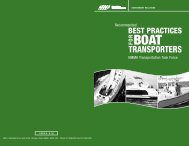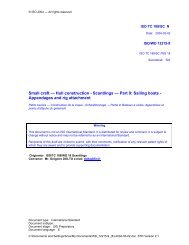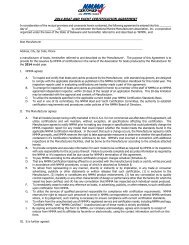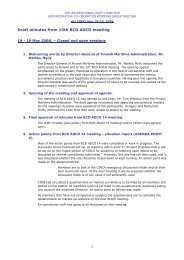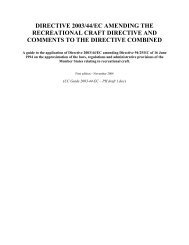global environmental legislation guide - National Marine ...
global environmental legislation guide - National Marine ...
global environmental legislation guide - National Marine ...
Create successful ePaper yourself
Turn your PDF publications into a flip-book with our unique Google optimized e-Paper software.
II. Recreational <strong>Marine</strong> Industry uses AF paints to proactively control (bio)fouling!Explanation:The potential for invasive aquatic species transferred through “(bio) fouling” to cause harmhas been recognized by the International Maritime Organization, the Convention onBiological Diversity (CBD), European Union, several UNEP Regional Seas Conventions (e.g.,Barcelona Convention for the Protection of the Mediterranean Sea Against Pollution), theAsia Pacific Economic Cooperation forum (APEC), and the Secretariat of the Pacific RegionEnvironmental Program (SPREP).Why is the transfer of invasive species a problemThe transfer of invasive aquatic species threatens freshwater and marine environments,human, animal and plant life, economic and cultural activities. Even if there is no visiblebiofouling it is important that preventative measures are taken. Once invasive aquaticspecies are established in a new habitat, they are often impossible to eradicate.IMO <strong>guide</strong>lines for ships and recreational craft:The IMO Guidelines for the Control and Management of Ships’ Biofouling to Minimize theTransfer of Invasive Aquatic Species (hereafter “the Guidelines”) aim to provide a <strong>global</strong>lyconsistent approach to the management of (bio) fouling. These <strong>guide</strong>lines include the SuperYachts (over 24 meter) . Recreational craft (below 24 meter): These Guidelines apply to allowners and operators of recreational craft below 24 meters in length. All craft canpotentially transfer invasive aquatic species.Controlling (bio) fouling:Operating profile has a great influence on (bio) fouling. The operating profile of theRecreational craft and Super Yachts differs from those of Commercial ships/vessels, especialfor operating speed, time underway compared with time moored or anchored, watertemperature, and where the craft/vessel is normally kept;“According to IMO by actively controlling the (bio)fouling by using AF paints on thecraft/vessel/ship, it will greatly reduce the risk of transfer of invasive aquatic species andcan also improve the craft’s speed and energy efficiency”.III. Zinc oxide use as a component in AF paintsThis section outlines how zinc oxide is used in antifouling paints, and provides a generalexplanation of the function of zinc oxide in antifouling paints. From this it is clear that zincoxide is added to antifouling paints to fulfil a non-biocidal function and not for the purposeof acting as a biocide.



